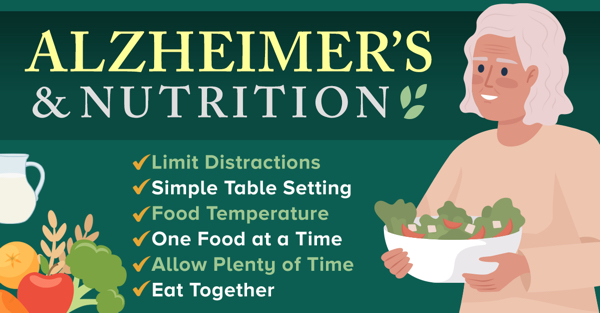If you’re caring for someone who has Alzheimer’s or a related dementia, you know that encouraging them to eat nutritious meals can be a daily challenge – especially during the middle and late stages of the disease.
“We work with many families who are experiencing this challenge,” said Sierra Goetz, co-founder and operations manager at Tudor Oaks Home Care’s partner, the HomeCare Advocacy Network (HCAN). “Refusal to eat can be caused by a number of things – there could be a medical condition, they may not recognize that food is something to eat, they may have lost the sense of hunger and thirst or they might get distracted at mealtime. Whatever the reason, it’s important to find ways to ensure they get the nutrition they need.”
The Alzheimer’s Association offers the following tips to help make mealtimes a little more calm and comfortable:
Limit distractions. Serve meals in quiet surroundings, away from the television and other distractions.
Keep the table setting simple. Avoid patterned plates, tablecloths and placemats that might confuse the person. Using color to contrast plates agains a tablecloth or placemat can make it easier for the person to distinguish the food from the plate or table. Provide only the utensils needed for the meal to avoid confusion.
Distinguish food from the plate. Changes in visual and spatial abilities may make it tough for someone with dementia distinguish food from the plate or the plate from the table. It can help to use white plates or bowls with a contrasting color placemat. Avoid pattered dishes, tablecloths and placemats.
Check the food temperature. A person living with dementia might not be able to tell if something is too hot to eat or drink. Always test the temperature of foods and beverages before serving.
Offer one food item at a time. The person may be unable to decide among the foods on his or her plate. Serve only one or two items at a time. For example, serve mashed potatoes followed by the main entree.
Be flexible with food preferences. It is possible the person may suddenly develop certain food preferences or reject foods he or she may have liked in the past.
Allow plenty of time to eat. Keep in mind that it can take an hour or more for the person to finish a meal.
Eat together. Give the person an opportunity to eat with others, Keeping mealtimes social can encourage the person to eat.
Keep in mind the person may not remember when or if he or she ate. If the person continues to ask about eating breakfast, consider serving several breakfasts – juice, followed by toast, followed by cereal.
“Many of us at Tudor Oaks Home Care have personal experience with dementia, so we understand the challenges that come with the disease – including those that occur at mealtime. That’s why we are committed to helping families navigate their care journey,” Goetz said. “Our professional caregivers are trained to provide exceptional care for those living with dementia – helping them remain safely in their homes for as long as possible, while giving family members a break and much needed peace of mind.”
For more information about Alzheimer’s care services, visit tudoroakshomecare.com.
